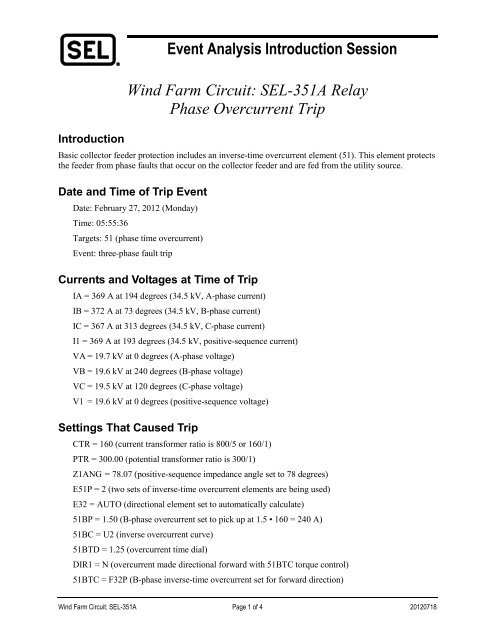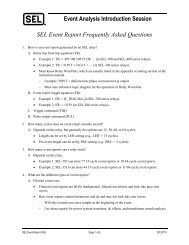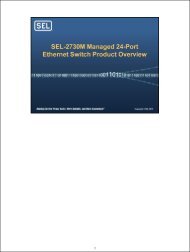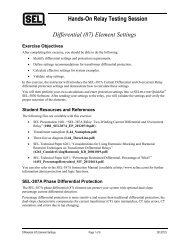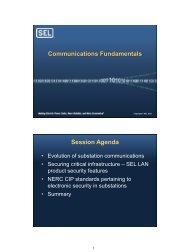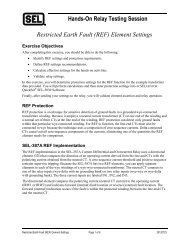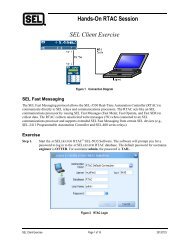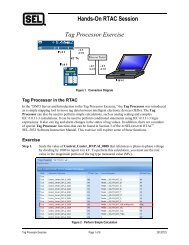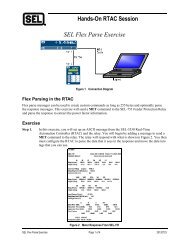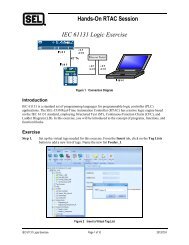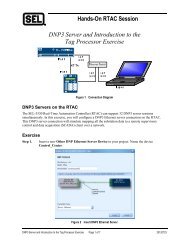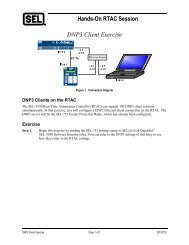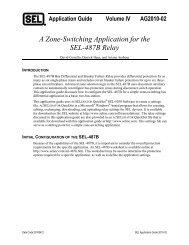SEL-351A Relay Phase Overcurrent Trip - CacheFly
SEL-351A Relay Phase Overcurrent Trip - CacheFly
SEL-351A Relay Phase Overcurrent Trip - CacheFly
- No tags were found...
Create successful ePaper yourself
Turn your PDF publications into a flip-book with our unique Google optimized e-Paper software.
Introduction<br />
Event Analysis Introduction Session<br />
Wind Farm Circuit: <strong>SEL</strong>-<strong>351A</strong> <strong>Relay</strong><br />
<strong>Phase</strong> <strong>Overcurrent</strong> <strong>Trip</strong><br />
Basic collector feeder protection includes an inverse-time overcurrent element (51). This element protects<br />
the feeder from phase faults that occur on the collector feeder and are fed from the utility source.<br />
Date and Time of <strong>Trip</strong> Event<br />
Date: February 27, 2012 (Monday)<br />
Time: 05:55:36<br />
Targets: 51 (phase time overcurrent)<br />
Event: three-phase fault trip<br />
Currents and Voltages at Time of <strong>Trip</strong><br />
IA = 369 A at 194 degrees (34.5 kV, A-phase current)<br />
IB = 372 A at 73 degrees (34.5 kV, B-phase current)<br />
IC = 367 A at 313 degrees (34.5 kV, C-phase current)<br />
I1 = 369 A at 193 degrees (34.5 kV, positive-sequence current)<br />
VA = 19.7 kV at 0 degrees (A-phase voltage)<br />
VB = 19.6 kV at 240 degrees (B-phase voltage)<br />
VC = 19.5 kV at 120 degrees (C-phase voltage)<br />
V1 = 19.6 kV at 0 degrees (positive-sequence voltage)<br />
Settings That Caused <strong>Trip</strong><br />
CTR = 160 (current transformer ratio is 800/5 or 160/1)<br />
PTR = 300.00 (potential transformer ratio is 300/1)<br />
Z1ANG = 78.07 (positive-sequence impedance angle set to 78 degrees)<br />
E51P = 2 (two sets of inverse-time overcurrent elements are being used)<br />
E32 = AUTO (directional element set to automatically calculate)<br />
51BP = 1.50 (B-phase overcurrent set to pick up at 1.5 • 160 = 240 A)<br />
51BC = U2 (inverse overcurrent curve)<br />
51BTD = 1.25 (overcurrent time dial)<br />
DIR1 = N (overcurrent made directional forward with 51BTC torque control)<br />
51BTC = F32P (B-phase inverse-time overcurrent set for forward direction)<br />
Wind Farm Circuit: <strong>SEL</strong>-<strong>351A</strong> Page 1 of 4 20120718
50P32P = 2.25 (directional phase-to-phase supervision = 2.25 • 160 = 360 A)<br />
TR = … + 51BT + … (B-phase inverse-time overcurrent set to trip)<br />
OUT101 = TRIP (output 101 used to trip the breaker)<br />
Summary of <strong>Trip</strong><br />
There was an increase in feeder current after the wind farm went into noncurtailment. The current was<br />
above the inverse-time overcurrent trip point and was seen to be in the forward-looking direction from the<br />
perspective of the <strong>SEL</strong>-<strong>351A</strong>. After about 5 seconds of increased current, the relay tripped the feeder<br />
breaker on the inverse-time overcurrent element set in the <strong>SEL</strong>-<strong>351A</strong>.<br />
Cause of <strong>Trip</strong><br />
According to the Sequential Events Recorder (SER) report, the directional element F32P picked up in the<br />
forward direction at 5:55:31. The inverse-time overcurrent element picked up and then timed out at<br />
5:55:36, about 5 seconds after the directional element picked up. Once the inverse-time overcurrent<br />
element timed out, the trip output closed to trip the breaker. This event information is shown below.<br />
05:55:31.340 F32P Asserted<br />
05:55:36.342 51BT Asserted<br />
05:55:36.342 OUT101 Asserted<br />
The directional element phase-to-phase current magnitude was at about 369 • 1.73 = 638 A, which is<br />
above the 360 A threshold of this element. The positive-sequence impedance (Z1) measured by the relay<br />
was as follows:<br />
Z1 = V1/I1 = (19600 at 0/369 at 193) = 53 at –193 ohms primary or 28 at 167 ohms secondary<br />
The relay considers anything within ±90 degrees of Z1ANG to be in the forward direction. The relay<br />
considers Z1ANG + 90 = 78.07 + 90 = 168 degrees to Z1ANG – 90 = 78.07 – 90 = –11.93 degrees to be<br />
in the forward direction. The Z1 impedance for this trip was just within this range at 167 degrees, so the<br />
relay declared this event to be in the forward direction. According to a wind farm drawing, the relay is<br />
connected so that the forward direction points into the wind farm and away from the utility.<br />
The B-phase current was 372/240 or 1.55 times the pickup of the B-phase overcurrent element. With this<br />
amount of overcurrent, the relay trips in a little over 5 seconds with the set curve and time dial.<br />
Wind Farm Circuit: <strong>SEL</strong>-<strong>351A</strong> Page 2 of 4 20120718
Graphs and Pictures<br />
The graph below shows the currents and voltages recorded by the <strong>SEL</strong>-<strong>351A</strong>.<br />
The plot below shows the magnitudes and angles of the currents and voltages at the time of the trip.<br />
Conclusions<br />
The <strong>SEL</strong>-<strong>351A</strong> tripped the breaker from an overcurrent condition caused by the <strong>SEL</strong>-<strong>351A</strong> seeing the<br />
increased current from the noncurtailment condition to be in the forward direction and above the<br />
overcurrent set point. Other feeder operations show that this same type of relay trip is occurring quite<br />
frequently at this wind farm. The relay seems to be operating correctly per the relay settings; however,<br />
this type of tripping operation should be evaluated according to the following recommendations.<br />
Wind Farm Circuit: <strong>SEL</strong>-<strong>351A</strong> Page 3 of 4 20120718
Recommendations<br />
The <strong>SEL</strong>-<strong>351A</strong> settings should be reevaluated with a full fault, load flow, and relay coordination study on<br />
the collector circuit feeders.<br />
Wind Farm Circuit: <strong>SEL</strong>-<strong>351A</strong> Page 4 of 4 20120718


